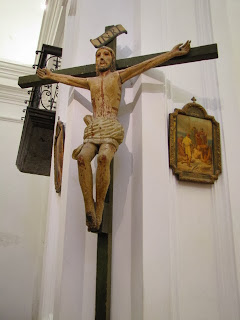 |
| A two level cloister housed the padres. The servant and slave quarters have disappeared, and the old farm and grass lands are now occupied by urban development. |
 |
| There are remains of an old wind mill, the 'tajamar' - water reservoir - and a large wine cellar. |
 |
| A pleasant court yard, graced with lavender bushes and orange trees houses also a well. The Estancia was used as a weapons factory between 1814-1816. |
 |
| Ripe oranges - ready for picking |
 |
| Long after the Jesuits were expelled, Estancia Coroya became the property of the Argentine Government in 1854. |
 |
| Museum rooms of the Estancia Caroya house a diverse collection of antique furniture and decorations |
 |
| In it's heyday, the Estancia raised around 15.000 mules a year to supply trade on the Camino Real. The Jesuits also raised sheep and cattle. |
 |
| Sanitary facilities date back to the original inhabitants, except with one noticable exception. This one without flushing mechanism, hence the bucket in the adjoining sink. |
 |
| The Jesuits represented a pround Christ on the Cross, with his back straight and his head lifted high and gazing into the distance |
 |
| However, this representation of Jesus looks as if knee replacements in ancient times were not very successful |
 |
| Several bells of the church are on display - all cracked or broken for various reasons.... |
 |
| Out of the way is definitely the right word, as Estancia Catalina is still surrounded by fields, grass land and sierra...the odd gaucho rides past or finishes his work in the fields |








